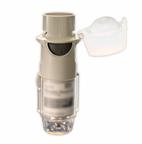How to Use a Soft Mist Inhaler

A soft mist inhaler (SMI) is a handheld device for taking medicine that must be breathed into the lungs (inhaled). The SMI changes a liquid medicine into a fine mist that can be inhaled. You may not feel the medicine going into your lungs. This is normal.
An SMI is used when a disease causes the breathing tubes to narrow (bronchospasm). Using an SMI can help prevent this and can keep the airway open. An SMI may be part of the long-term treatment for asthma or chronic obstructive pulmonary disease (COPD). In many cases, it is used twice a day.
What are the risks?
-
If the medicine in the SMI is a steroid, it can cause mouth sores. To prevent this, rinse your mouth after you use the SMI. Gargle and spit out the water. Do not swallow the water.
-
If you do not use the SMI in the right way, the medicine may not reach your lungs.
-
The medicine in the SMI may cause side effects. Read the package insert for the medicine to learn more. Ask your health care provider or pharmacist if you have more questions.
Supplies needed:
The SMI. The medicine that you inhale comes with the SMI.
How to use an SMI
Preparing a new SMI for use
-
To remove the clear base of the SMI, press the safety catch on the cap with your thumb. Pull off the clear base with your other hand.
-
On the label, write the date that will be 3 months from now. This is the date when you should throw away the SMI.
-
Place the medicine cartridge into the base of the SMI. Press the cartridge on a flat surface to click it into place. Click the clear base back into place over the cartridge.
-
Turn the clear base in the direction of the arrows on the label until you hear a click.
-
Open the cap on top of the SMI. It should snap open all the way to show you the mouthpiece.
- Prepare (prime) the SMI for use. To do this, point it toward the ground. Press on the dose-release button below the mouthpiece. You should see the release of some mist. If you do not see mist, close the cap, turn the base, open the cap, and prime the SMI again until you see the mist.
Do not get any mist into your eyes.
If you do not see the mist when priming, return the SMI to your pharmacist for help.
Taking an inhaled dose
-
Hold the SMI upright.
-
Use your thumb and pointer finger to turn the base of it until you hear a click.
-
Open the cap until you hear a click.
-
Hold the SMI in one hand with your pointer finger over the dose-release button.
-
Turn your head away from the SMI. Breathe out slowly.
-
Close your lips around the mouthpiece.
-
Point the SMI toward the back of your mouth.
-
Press the dose-release button while taking a slow, deep breath through your mouth.
-
Hold your breath for 10 seconds, or as long as you can.
-
Turn your head away. Breathe out slowly through pursed lips.
-
Inhale the medicine a second time, if told to do so by your provider. Wait at least 30–60 seconds after the first dose. Do not take extra doses even if you do not feel the mist as you inhale.
Follow these instructions at home:
Caring for your SMI
-
Keep track of your doses. When the indicator is in the red zone, you have 7 days left. Get a refill at this time. The SMI will lock when it is empty.
-
Store the SMI in a cool, dry place at room temperature.
-
Do not wash your SMI. If the mouthpiece gets dirty, use a dry cloth to wipe it clean.
-
If the SMI has not been used for a few days, you will need to prime it again. Check the package insert that comes with your SMI for instructions on how to do this.
General instructions
-
Take your inhaled medicine only as told by your provider. Do not use the SMI more than you are told to.
-
Do not use any products that contain nicotine or tobacco. These products include cigarettes, chewing tobacco, and vaping devices, such as e-cigarettes. If you need help quitting, ask your provider.
Contact a health care provider if:
-
Your symptoms do not get better with the SMI.
-
You have side effects from the medicine.
-
You have a cough that will not go away.
-
You are not sure how to use the SMI.
-
Your inhaler is not working like it should.
-
You have severe shortness of breath or trouble breathing.
-
You have chest tightness or chest pain.
-
You have an allergic reaction. Symptoms may include an itchy rash, swelling of the face or tongue, or trouble breathing.
These symptoms may be an emergency. Get help right away. Call 911.
This information is not intended to replace advice given to you by your health care provider. Make sure you discuss any questions you have with your health care provider.
